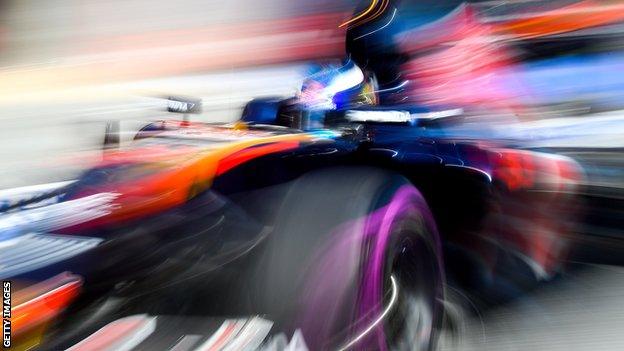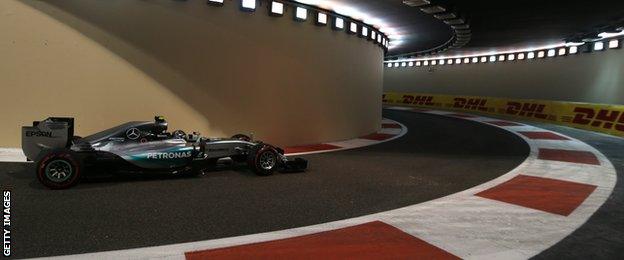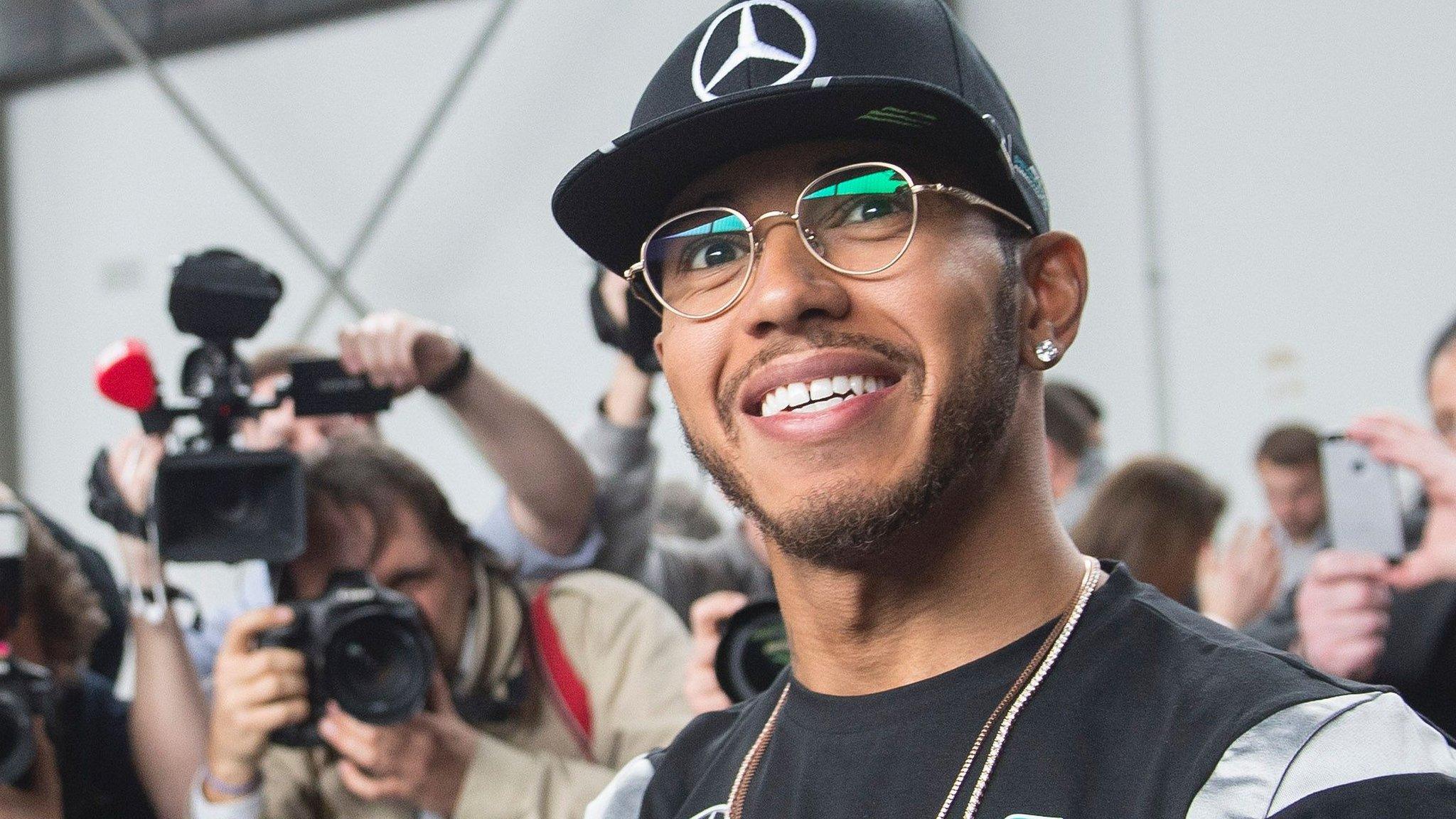Formula 1 2016: Allan McNish's season preview
- Published
- comments

Ferrari ended pre-season testing with the fastest lap times but there is absolutely no doubt that once again Mercedes are in the best shape heading into the new Formula 1 season.
There are 21 grands prix this year - the longest season ever - so reliability will be paramount and the mileage the world champions achieved was nothing short of remarkable.
They basically did an entire grand prix season in eight days in Barcelona - the same mileage as they managed last winter in 12 days.
That was 31% more than main rivals Ferrari. Which means they have 31% more data to work from going into the championship.
Mercedes already had a fast car and they have refined it, rather than make any huge changes, while Ferrari have revised quite a lot of features of their car.
And the Mercedes clearly does not lack for pace - when Nico Rosberg did finally put a set of soft tyres on, he was within spitting distance of the best times set by the Ferrari drivers on even softer tyres.
Can Ferrari threaten Mercedes?

Ferrari ended pre-season testing with the fastest times - but it's never as simple as that in F1
The signs are that Ferrari are closer this year. Last year, they were a second off the pace at the first race of the season and they still won three races and got in amongst it, scoring more podiums than they did in 2013 and 2014 combined.
They are moving in the right direction and, this year, it already looks as if they have reduced Mercedes' advantage. But the key for Ferrari will be whether they can qualify well.
Their record on Saturdays has been pretty woeful in the last few years, with only five poles this decade, whether it was Sebastian Vettel or Fernando Alonso leading the team. Last season they were closer, but still on average over the season 0.689 seconds behind Mercedes.
Whenever Ferrari made it on to the front row last year, they had a chance. They put Mercedes under pressure, exposed some weaknesses and were able to get in the mix.
If, as it appears, they are that bit closer again this year, Vettel could well make things awkward for Mercedes.
Can Rosberg finally beat Hamilton?

Rosberg beat Hamilton hands down in the final three races of last season... after Hamilton had wrapped up the title
A lot has been made of the way Rosberg ended last season on a high, winning three races in a row, taking six consecutive poles and Hamilton seemingly unable to beat him.
Many have wondered aloud whether he can continue that run and put Hamilton under some pressure.
That remains to be seen. But there is no mystery to why 2015 ended the way it did.
Hamilton became a back-to-back champion with three races still to go. He had put a lot of energy into achieving that and, when the title was in the bag, he lifted off the throttle a little.
People should not underestimate the emotional investment a driver puts into trying to win a world title. It takes an awful lot out of you, so it's no surprise Hamilton was not on top form once it was settled.
The question is, can he kick-start all that again and come out of the blocks as he did last year, or is he going to be a bit subdued?
Hamilton's testing did not seem to go that well - he was talking about struggling on the softer tyres and Rosberg set quicker times than he did.
Testing is one thing; racing quite another. Rosberg was pasted by Hamilton at the start of last year and I suspect that was partly down to the effects of the way he lost the title at the final race of 2014.
I've been through losing a world championship at the last race, and I can tell you it takes a long time to get over it and come back again. You saw that with Mark Webber at Red Bull in 2011, and I think the same thing happened to Rosberg last year.
This year is a bit different - yes, Rosberg got beaten again in 2015, but he ended the season on a high rather than a low.
Maybe that was down to him being freed up psychologically after the title was lost. It could have been to do with a change in the car's behaviour following the increase in minimum tyre pressures late in the season. Perhaps once his baby daughter was born and he became a father, that was one more pressure out of the system.
I've seen Nico around Monaco a couple of times this winter and he seems pretty calm. I think he is in a pretty good place right now.
The first qualifying session of the season will set the tone. If it's a clean session and Rosberg can beat Hamilton, things could get very interesting.
Can Raikkonen cut it?

He is widely regarded as a huge talent, but Kimi Raikkonen could not get close to team-mate Vettel last season
Ferrari would love Vettel's team-mate Kimi Raikkonen to join the German in taking the fight to the Mercedes.
It looks as if the car suits Raikkonen better again this year, just as it did last year compared to 2014. But Vettel had about 0.4secs on Raikkonen last year and it's hard to imagine that gap will close much.
One thing that could help Ferrari is the increased freedom on tyre choice this year, with three types of tyres rather than two available each weekend, and teams able within restrictions to choose how many of each they want.
In the past, Ferrari have tended to go better the softer the tyre, so this could potentially help them and enable them to look at doing something different strategically.
Ferrari have chosen for their drivers exactly the same mix of tyres as Rosberg for Australia - with Hamilton the one out on a limb in choosing only one set of mediums and an extra pair of softs.
This offers Ferrari, and Rosberg, a chance to do one fewer pit stop than Hamilton in Melbourne, which could spice things up a bit.
The others

Williams surprised Mercedes and Ferrari in few races last season
Williams look like they are best of the rest, closely followed by the two Red Bull teams and Force India. That four-way fight looks like being pretty intense.
Red Bull are still using a Renault engine this year - although it is badged as a Tag Heuer after a sponsor. That power-unit has improved significantly over the winter, but it is still down on performance compared to Mercedes and Ferrari, which will make life difficult for Red Bull, especially during races.
Force India are feeling quite good about the balance and consistency of their car. They are unlikely to have the consistency to challenge Red Bull and Williams all the time due to the pace of development through the season the bigger teams will be able to achieve, but they will have a good go at it on certain types of circuit.
What about McLaren?

McLaren's painfully slow progression looks set to continue in Australia
The manufacturer with the most room for improvement was McLaren's partner Honda. It looks better for them - but not better enough.
The biggest weakness of that engine - hybrid energy deployment - has been vastly improved. But it remains a long way down on overall performance and McLaren are still in the region of two seconds off the pace and still have one of the slowest top speeds.
One thing did stand out in pre-season testing, though - McLaren were the team with the biggest disparity between actual lap time and theoretical best lap time (when you put together all the best sectors achieved by a driver on different laps).
That can only be down to two things - either they are disguising their true pace a little; or the car is inconsistent in its behaviour.
If it's the first, it's not going to make a huge difference, perhaps a couple of tenths of a second a lap. If it's the second, that's bad news for Jenson Button.
He held his own very well against Fernando Alonso last year but will undoubtedly struggle more if the car is difficult to predict in the way it drives.
We already saw this a couple of times in 2015 - when the car was wayward, such as in Spain and Singapore, Alonso was suddenly a long way ahead. There's no-one better in a tricky car than Alonso; and Button struggles in one more than some others.
Whatever, that team still has a long way to go before they are where they want to be and contending for race wins and championships.
A new-look qualifying

The new knock-out qualifying could potentially make things less entertaining
There will be a new qualifying format introduced at the first race of the season after what can only be described as a bizarre backwards and forwards process in the last couple of weeks.
First it was going to be introduced, then it wasn't, then it was but with tweaks, and then finally the original plan was agreed after all - all in the space of seven days.
I found it particularly ironic to hear Bernie Ecclestone say his company could not make the necessary changes to the timing systems and television graphics in the timescale, when they were asking the teams to do exactly the same.
Anyway, the new knock-out system has been brought in, not because there was anything wrong with qualifying in the first place, but in the hope that it could mix up the grids a bit as a result of teams making mistakes.
That could indeed happen to a degree. But one corollary is that the teams that are more efficient in terms of their tyre usage, their hybrid energy and general ability to crunch numbers will benefit - and they are the teams who are already at the front.
In the past, we've seen top teams - particularly Ferrari - miscalculate the cut-off time and end up being knocked out early. But now teams are going to have to be out on track to ensure they can respond when necessary.
I suspect what will happen is that teams will set a lap and then cruise around keeping their hybrid systems charged and their tyres up to temperature so they are able to do another lap if they need to.
Where it might have a negative effect is in the final shoot-out for the top eight positions. It's going to end up with only two drivers left - and it's quite possible that we'll know after the first sector of the lap who's going to be on pole.
And that's not ideal - after all, some people pay to see Saturday's action. There's an appeal in seeing who is the absolute fastest over one lap.
Allan McNish was talking to BBC Sport's Andrew Benson
- Published13 March 2016

- Published12 March 2016

- Published11 March 2016

- Published27 March 2016

- Published9 March 2016

- Published18 December 2015

- Published2 November 2018

- Published26 February 2019
